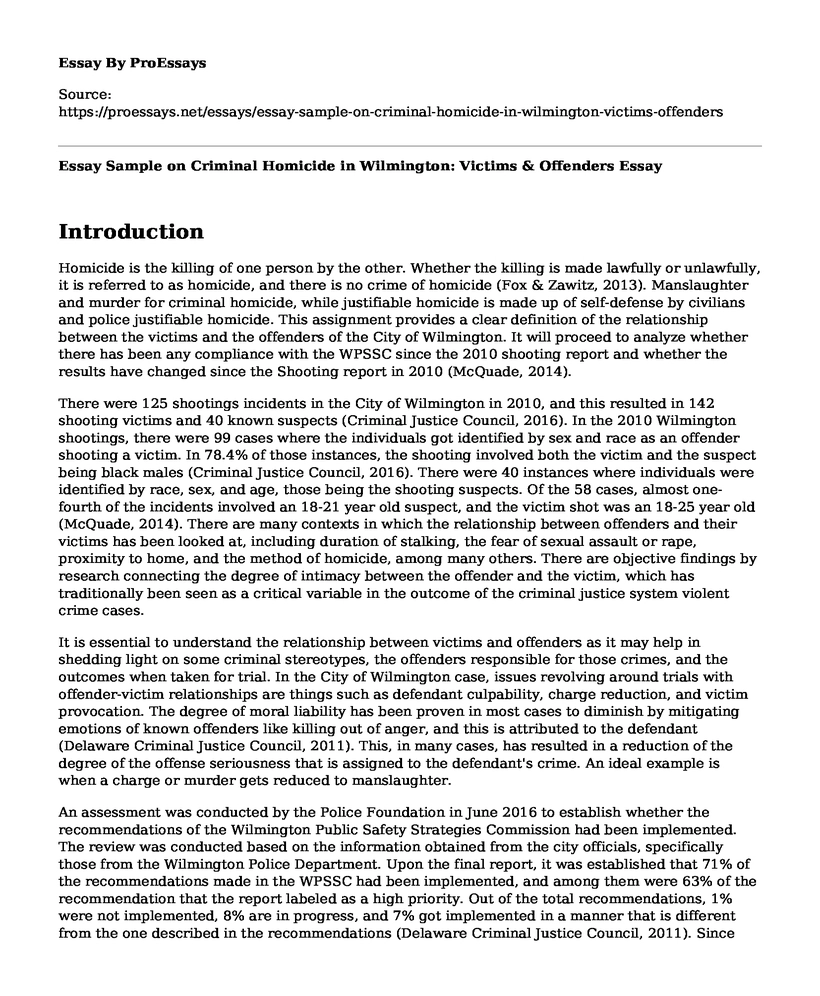Introduction
Homicide is the killing of one person by the other. Whether the killing is made lawfully or unlawfully, it is referred to as homicide, and there is no crime of homicide (Fox & Zawitz, 2013). Manslaughter and murder for criminal homicide, while justifiable homicide is made up of self-defense by civilians and police justifiable homicide. This assignment provides a clear definition of the relationship between the victims and the offenders of the City of Wilmington. It will proceed to analyze whether there has been any compliance with the WPSSC since the 2010 shooting report and whether the results have changed since the Shooting report in 2010 (McQuade, 2014).
There were 125 shootings incidents in the City of Wilmington in 2010, and this resulted in 142 shooting victims and 40 known suspects (Criminal Justice Council, 2016). In the 2010 Wilmington shootings, there were 99 cases where the individuals got identified by sex and race as an offender shooting a victim. In 78.4% of those instances, the shooting involved both the victim and the suspect being black males (Criminal Justice Council, 2016). There were 40 instances where individuals were identified by race, sex, and age, those being the shooting suspects. Of the 58 cases, almost one-fourth of the incidents involved an 18-21 year old suspect, and the victim shot was an 18-25 year old (McQuade, 2014). There are many contexts in which the relationship between offenders and their victims has been looked at, including duration of stalking, the fear of sexual assault or rape, proximity to home, and the method of homicide, among many others. There are objective findings by research connecting the degree of intimacy between the offender and the victim, which has traditionally been seen as a critical variable in the outcome of the criminal justice system violent crime cases.
It is essential to understand the relationship between victims and offenders as it may help in shedding light on some criminal stereotypes, the offenders responsible for those crimes, and the outcomes when taken for trial. In the City of Wilmington case, issues revolving around trials with offender-victim relationships are things such as defendant culpability, charge reduction, and victim provocation. The degree of moral liability has been proven in most cases to diminish by mitigating emotions of known offenders like killing out of anger, and this is attributed to the defendant (Delaware Criminal Justice Council, 2011). This, in many cases, has resulted in a reduction of the degree of the offense seriousness that is assigned to the defendant's crime. An ideal example is when a charge or murder gets reduced to manslaughter.
An assessment was conducted by the Police Foundation in June 2016 to establish whether the recommendations of the Wilmington Public Safety Strategies Commission had been implemented. The review was conducted based on the information obtained from the city officials, specifically those from the Wilmington Police Department. Upon the final report, it was established that 71% of the recommendations made in the WPSSC had been implemented, and among them were 63% of the recommendation that the report labeled as a high priority. Out of the total recommendations, 1% were not implemented, 8% are in progress, and 7% got implemented in a manner that is different from the one described in the recommendations (Delaware Criminal Justice Council, 2011). Since 2010 after the WPSSC recommendations, there have been positive changes in the results about the number of shootings in Wilmington. However, the city continues to experience high levels of violence in some neighborhoods. As a result, some of the key recommendations should be re-considered, especially those that appeared not to have been implemented fully.
References
Criminal Justice Council July (2016). An Assessment of Wilmington's Implementation of the Wilmington Public Safety Strategies Commission Recommendations. https://www.wilmingtonde.gov/home/showdocument?id=1218
McQuade, M. K. (2014). Victim-offender relationship. The Encyclopedia of Criminology and Criminal Justice, 1-5. https://onlinelibrary.wiley.com/doi/10.1002/9781118517383.wbeccj131
Fox, J. A., & Zawitz, M. W. (2013). Homicide Trends in the United States. BJS: Bureau of Justice Statistics. https://www.bjs.gov/index.cfm?ty=pbdetail&iid=967
Delaware Criminal Justice Council (2011, November). Wilmington Shootings 2010: A Comparative Working Paper. https://cjc.delaware.gov/wp-content/uploads/sites/61/2017/06/2010ShootingReportFinal_min.pdf
Cite this page
Essay Sample on Criminal Homicide in Wilmington: Victims & Offenders. (2023, Mar 27). Retrieved from https://proessays.net/essays/essay-sample-on-criminal-homicide-in-wilmington-victims-offenders
If you are the original author of this essay and no longer wish to have it published on the ProEssays website, please click below to request its removal:
- Essay on the Gun Control Issue in the United States
- Why Texas Should Not Lower the Drinking Age Essay
- Fictional Representations of Crime in TV Programs and Movies Paper Example
- Corrections: Last Step in Criminal Justice System - Essay Sample
- Juvenile Corrections: Probation and Beyond - Essay Sample
- Paper Example on Online Child Sexual Abuse: An Increasing Global Epidemic
- Free Essay Example on Gun Violence in America: An Alarming Reality







